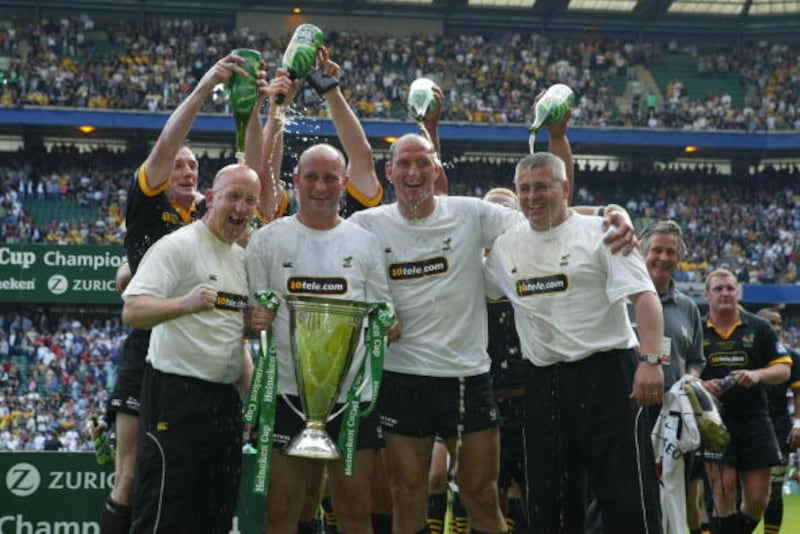A young journalist’s worst nightmare is looking foolish in a press room full of grizzled veterans. You raise the head above the parapet, ask a player or coach a question, only to be met with a response that suggests you should have thought twice.
After Ireland’s most recent victory over Wales, when asked to look forward to England, Andy Farrell suggested his players would be well-equipped to deal with the threat of their new blitz defence: “It’s something we’ve come up against before and we all know that our lads are coached by the coach that made it up in the first place, so . . .”
Jacques Nienaber, the mastermind of South Africa’s blitz system, now coaches the majority of the Ireland squad at Leinster. This correspondent made the link and foolishly asked Farrell if that’s who he was referencing.
“You said that,” he shot back. “Do you think that’s what I meant?”
Cue laughter from the grizzled veterans.
Embarrassment aside, Farrell’s comments raise an intriguing question. Many have used the blitz, arguably the most risky yet rewarding defensive system in the game, but who actually came up with it?
In these pages last week, Gerry Thornley suggested that Farrell was giving himself credit, given his background as a defence coach with England, the Lions and of course Ireland before he got the main gig.
Farrell has a reputation for encouraging his defenders to be aggressive, to stifle the opposition with speed and athleticism. None more so than on the Lions Tour of 2013, where he was Warren Gatland’s defence coach.

“Faz wanted our line speed to be so aggressive that the attack couldn’t go beyond two or three passes,” said Sam Warburton, Lions captain that year, on the The Ruck podcast. “You cut it off.”
In the England camp, Felix Jones is the current mastermind of England’s aggressive system. He worked with Nienaber at South Africa; the didactic link is clear.
Given the distance between Farrell in the UK and Ireland and Nienaber in South Africa, it’s tough to gauge who did what first or who is copying whom.
Yet the blitz has been there for all to see in the Northern Hemisphere long before Nienaber or Farrell came into view. Shaun Edwards has arguably been the hottest commodity among defence coaches due to his work in implementing the aggressive system.
Edwards’ blitz defence was credited by many a Welsh player for their success during his time working on Gatland’s coaching ticket, winning three Grand Slams in 2008, 2012 and 2019. In 2020, he moved to France, taking his system to Fabien Galthié's squad.
That broke up a partnership with Gatland that stemmed back to their days coaching Wasps in the early noughties. Edwards, Gatland and blitz are three words that have frequently been in the same sentence given Wasps’ success in that era, winning the Heineken Champions Cup in 2004. Which of the duo came up with the system first?
In a recent column in The Telegraph, Gatland said he first started implementing it when coaching Galwegians and Connacht in the ‘90s. “In those days there was not the same level of video analysis so you could really catch teams out with it,” he said.

“Nowadays every piece of play is coded and the analysis is microscopic but when I joined Wasps in 2002 I had a conversation with Shaun Edwards, who was our defence coach at the time, and said I wanted to introduce an aggressive blitz defence.”
Speaking to a Wasps fan site in 2006, Edwards himself said, given his rugby league background, a discrepancy between the laws of league and union inspired him to get on board when Gatland made his suggestion.
“Having come from rugby league, where you had to be 10 yards back, I reckoned that one yard back isn’t that far. I sensed that players with sufficient speed could get up there and really pressurise the opposition.”
So Gatland used the blitz first while Edwards theorised before putting his own stamp on it when the two came together. Yet in the same interview, the Wigan native said he first saw the blitz from South Africa when they won the World Cup in 1995.
All roads lead back to the ‘Boks. Given we have traced a path back to the start of professionalism, it is almost certain that a club side shielded by a lack of media scrutiny at amateur level would lay claim to the system long before South Africa.
If everyone can lay claim to the origins of the blitz, can anyone do so legitimately? Does it even matter? The only real issue of significance is the ability of Jones and England to stifle an Ireland attack leading the way in countless statistical categories.
Farrell may attempt to lay claim to what he sees as his own work, but he will be far more concerned with Saturday than the past.






